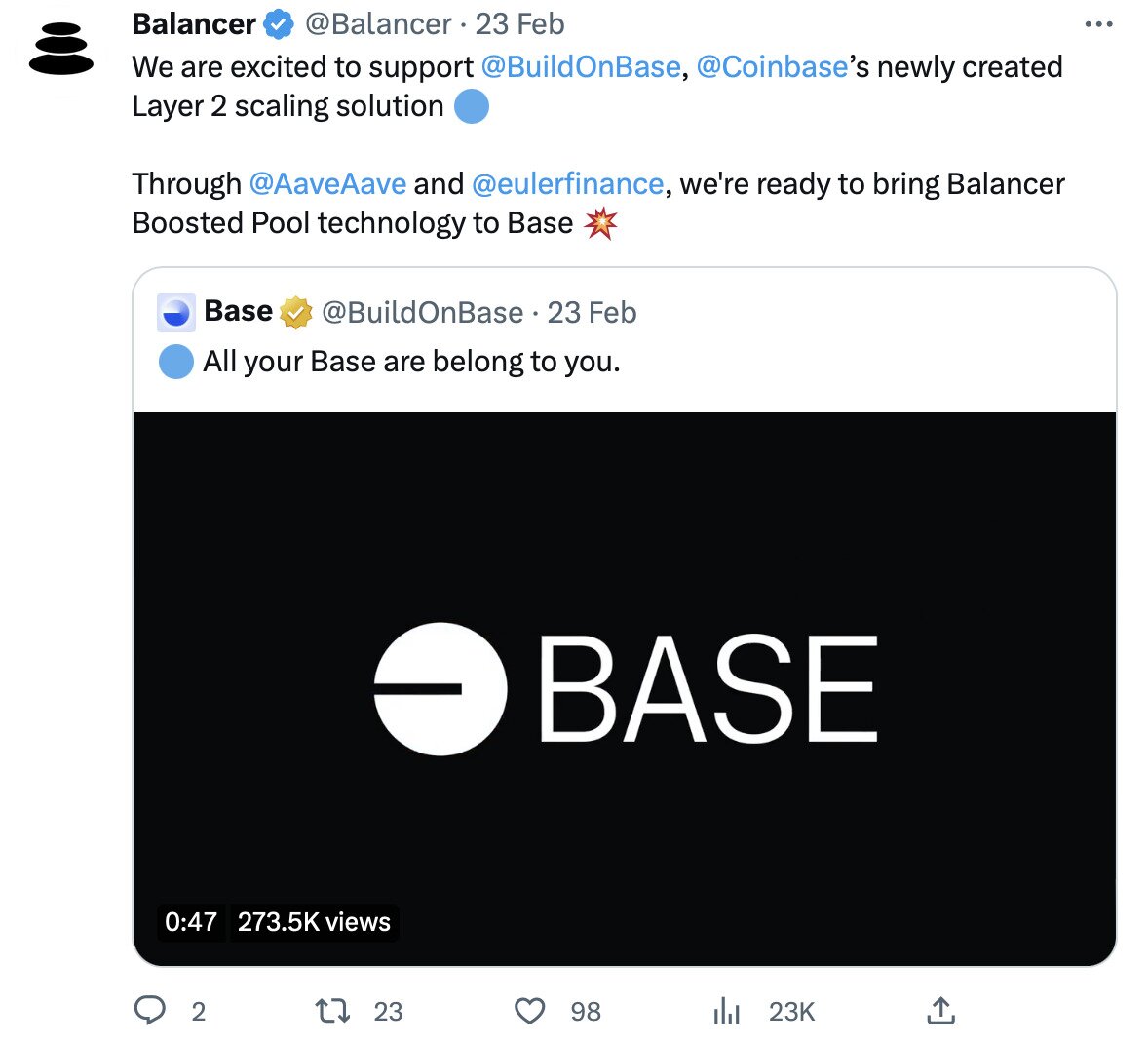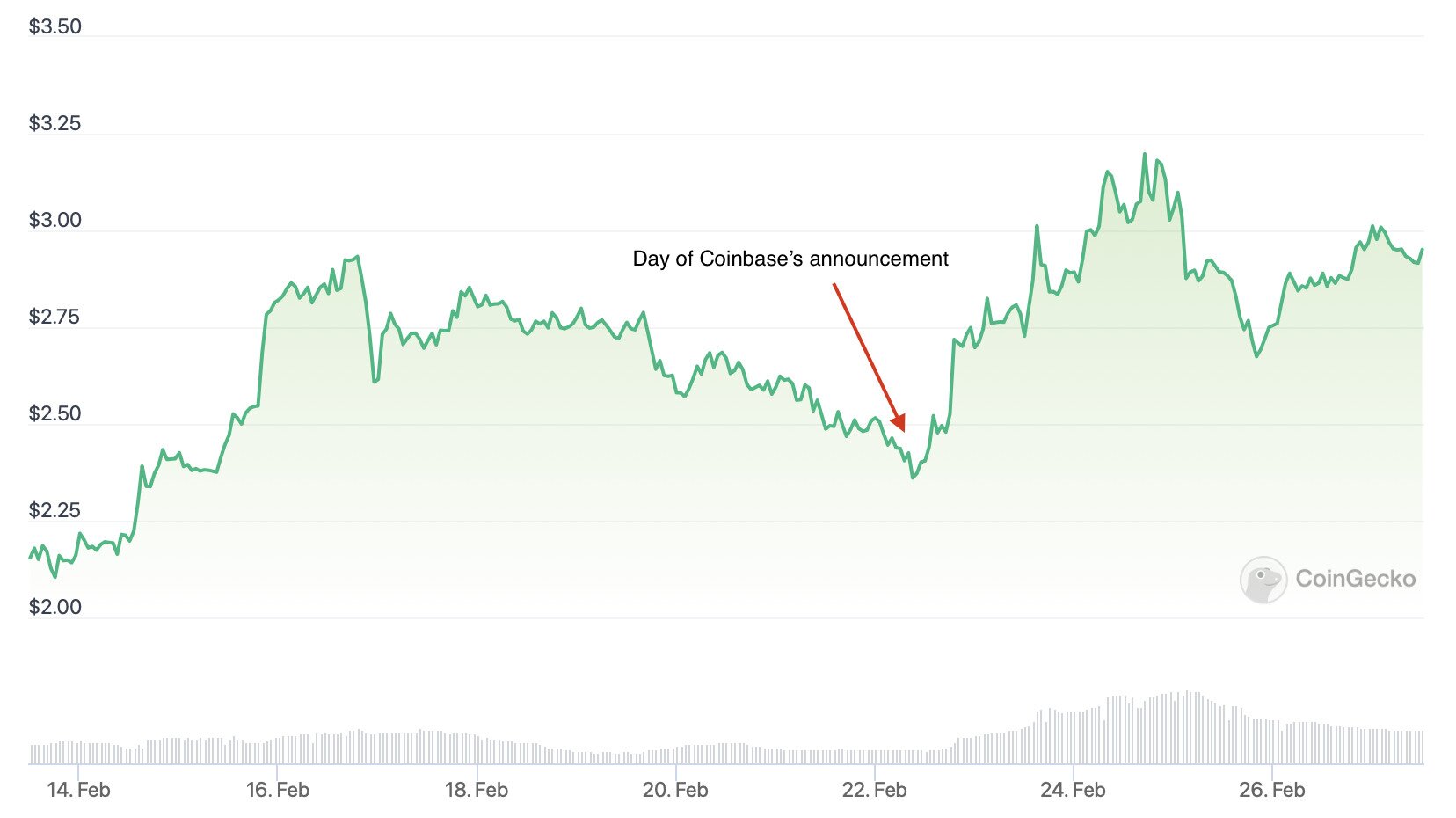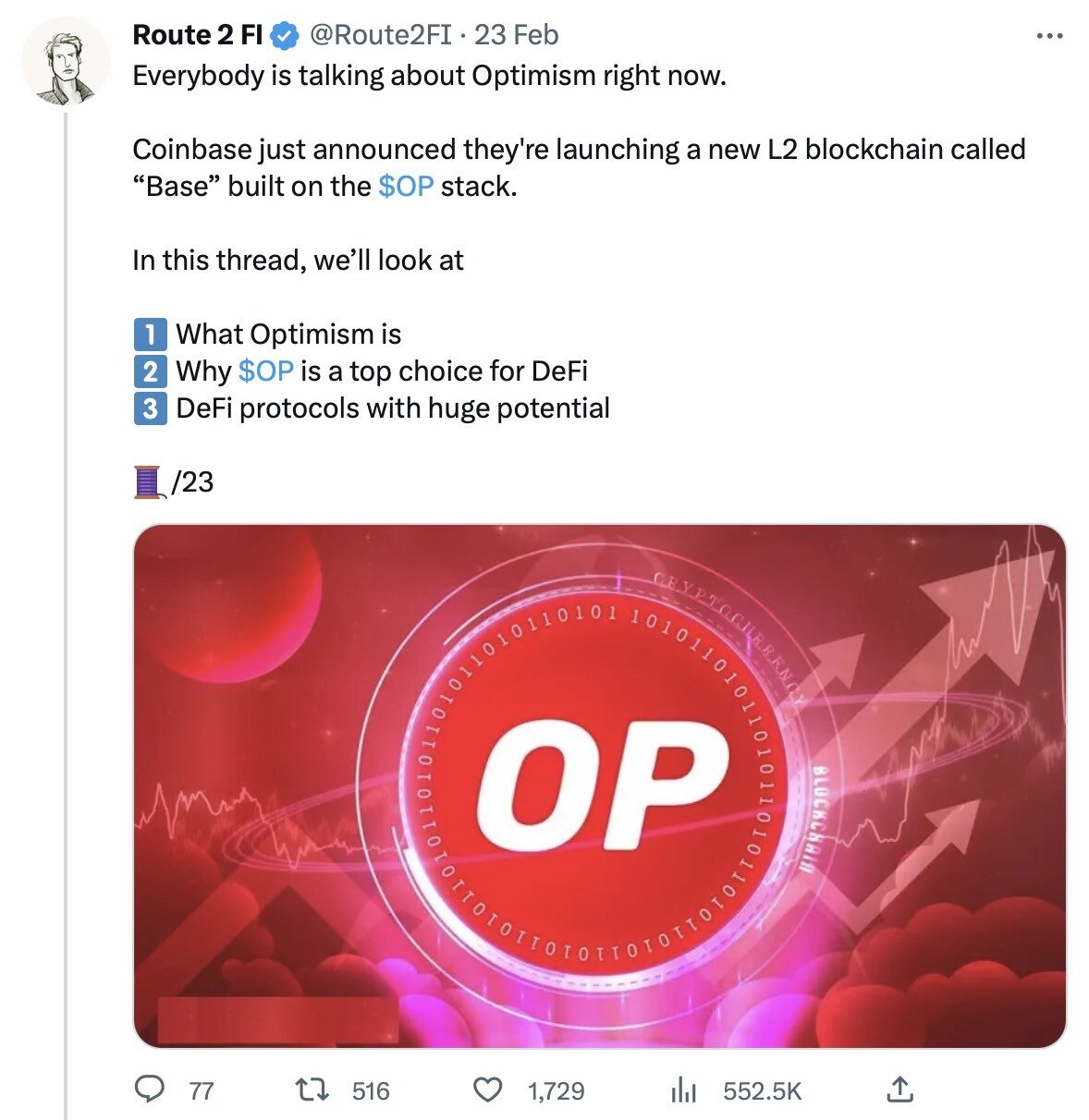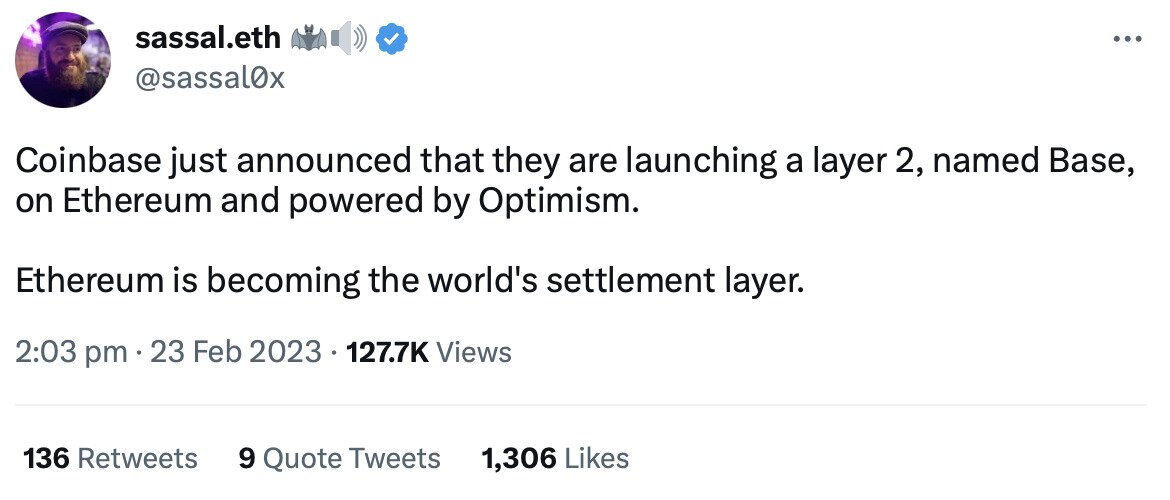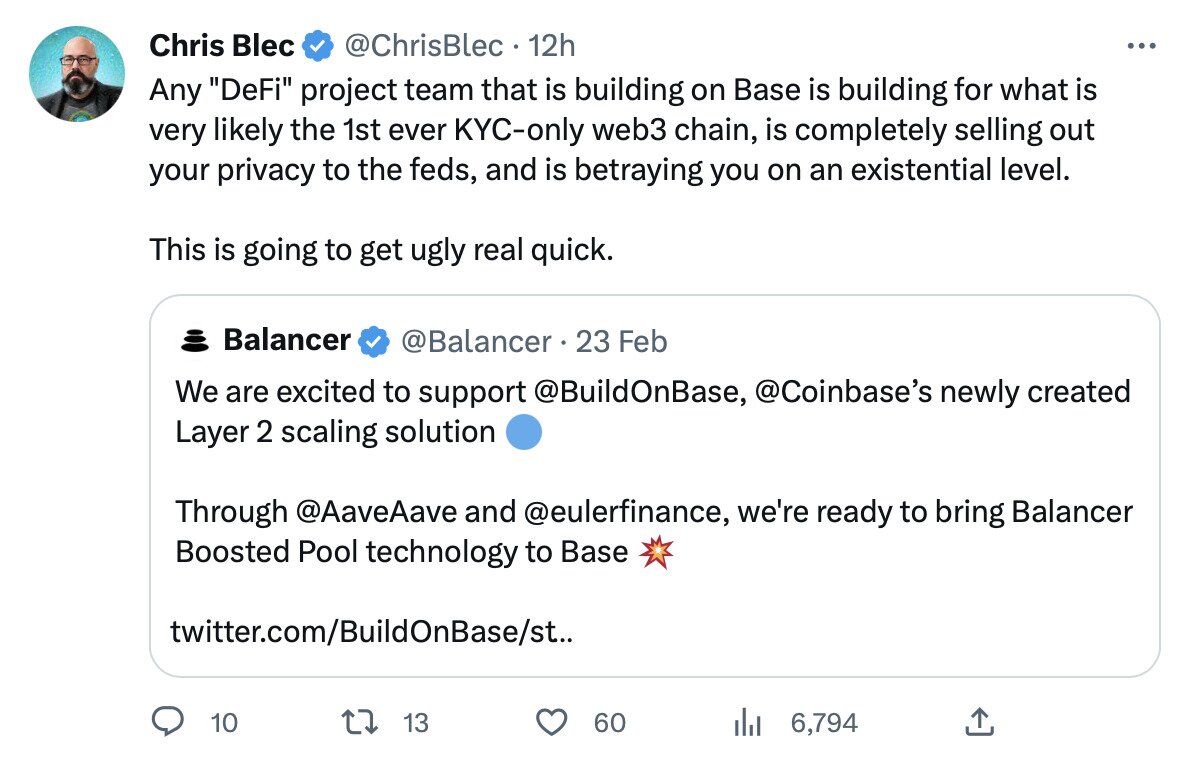- >News
- >Coinbase Announces Its Own Layer Two Network: Which Cryptos Will Be the Biggest Winners?
Coinbase Announces Its Own Layer Two Network: Which Cryptos Will Be the Biggest Winners?
There’s little doubt that exchanges are the biggest players in the cryptocurrency industry. When Binance or Kraken sneezes the market catches a cold, and when a trading platform announces some big new launch or project, investors should really sit up and pay attention. This is particularly the case in the event an exchange reveals their very own platform, which is something US-based exchange Coinbase did last week, when it introduced Base to the world.
As detailed in an official blog, Base will be a layer-two sidechain for Ethereum, one which Coinbase hopes will provide “a secure, low-cost, developer-friendly way for anyone, anywhere, to build decentralized apps or ‘dapps’ onchain.” While Base itself won’t have its own native token, it’s clear that the layer-two’s arrival will provide a big boost to the cryptocurrency market in general, as well as a few other platforms in particular.
Indeed, with Base developed from open-source code written for Optimism (another Ethereum-based layer-two solution), OP will be one token that should witness steady gains once Base gets going. And with Coinbase also aiming to “bring the next billion users to web3,” Ethereum itself will be perhaps the major beneficiary, given that all Base transactions will be settled on the Ethereum blockchain. This could make 2023 a very strong year for ETH, which is also likely to benefit from the ongoing development instigated by last year’s Merge.
Coinbase Announces Base, Optimism and Ethereum Rally
Coinbase announced the launch of Base’s testnet last week, meaning that the layer-two network is already accessible to developers and other early testers. In fact, early reports suggest that over 100 developers have already begun contributing to the project, while a growing number of platforms have already revealed that they’ll be joining Base’s ecosystem and collaborating with the project. This provides some indication of just how big it could end up becoming.
Source: Twitter
As written in the aforementioned blog, Base will be built with a focus on four core features:
-
Secured and settled on the Ethereum blockchain
-
Designed to integrate with Coinbase’s existing products, services and features
-
Full Ethereum Virtual Machine (EVM) compatibility and low fees, including feeless transactions for developers
-
Open source and based on Optimism’s stack of development software
With regards to this final core feature, Coinbase has also joined Optimism as the second core developer on Optimism’s open-source OP Stack, meaning that the exchange will effectively be writing code for Optimism as well as for itself.
Perhaps more interestingly, Coinbase has also written in an accompanying blog that, with Optimism and its developers, it has a “shared vision for a superchain.” What this means is the use of Optimism’s OP Stack will potentially give rise to other layer-twos in addition to Base and Optimism, and that these sidechains “will gradually increase their interoperability until they form a ‘mesh’ or ‘Superchain’ that jointly scales Ethereum.”
In other words, Coinbase does not see itself as a competitor with Optimism or other layer-two networks for Ethereum, but rather a collaborator. As it explains, the exchange believes “this decentralized effort will create the foundation for a much more vibrant developer ecosystem than what would be possible by a single chain alone.”
Optimism (OP) price in the past 14 days. Source: CoinGecko
This focus on interoperability and collaboration is key here, because it explains why Optimism’s native token — OP — rallied by as much as 35% in the 24 hours following Coinbase’s unveiling of Base. And it remains 30% up in the last 30 days, with investors expecting that Optimism will only grow in the long term, now that Coinbase is part of its ecosystem.
Source: Twitter
As a pre-existing layer-two network, Optimism currently accounts for a total value locked in of $950 million (more than Cardano, Fantom and Solana). This TVL has already risen by 90% since the start of the year, indicating rising usage of Optimism, yet it’s only likely to rise further in the coming months and years.
But let’s not forget Ethereum, which as the underlying settlement layer for Base and Optimism will be the ultimate beneficiary of Coinbase’s new venture. Remember that Coinbase has the stated aim of bringing one billion more users to the cryptocurrency ecosystem, and given its resources and reach, it could come close to achieving such a goal.
Combined with lower fees and faster transactions, this would ultimately mean much more use of Ethereum, which in turn means more demand for native token ETH and higher price for the altcoin. As one prominent Ethereum supporter (Anthony Sassano) put it, “Ethereum is becoming the world’s settlement layer.”
Source: Twitter
Questions and Losers
Of course, not everyone is bowled over by Coinbase’s news, and for a variety of reasons. Firstly, some have raised legitimate questions about whether Coinbase’s development of base could somehow invite greater decentralization or more restrictions into the layer-two and wider crypto ecosystem.
For instance, podcast host Chris Blec noted in a tweet that “Coinbase is subject to the Bank Secrecy Act, Patriot Act & more.” He therefore asked, “How will Coinbase comply with these laws without requiring KYC on bridged funds?”
Source: Twitter
This is an important question, and so far Coinbase doesn’t seem to have answered it. Assuming that the exchange would need to apply KYC controls to all users of Base, this could restrict its growth, with some potential users being deterred by the need to identify themselves to use it. That said, it’s arguable that Base is likely to attract the kind of people who wouldn’t have a problem with KYC anyway, including many within the mainstream.
At the same time, it’s also possible that other, non-Optimism layer-two networks will suffer as a result of Coinbase’s entry. This is supported by the fact that Polygon (MATIC) and Loopring (LRC), for instance, are both down by 15% and 16%, respectively, in the past two weeks.
It’s also possible that Binance’s own BNB Chain may be hurt by Coinbase’s launch of Base. Because with the American exchange throwing its weight behind the Ethereum network and ecosystem, the latter is set to become more usable and efficient in the not-too distant future, putting BNB Chain at a potential disadvantage. This might explain why BNB is down by 2% in the past week, fortnight and month, when many coins are up.
Regardless of what happens to rivals, Coinbase’s unique position at the top of the cryptocurrency food chain means that Base has the strong foundation it needs to become a highly used layer-two for Ethereum-based transactions. In the long run, this potentially means more people using NFTs, more people using Web3, and more people entering the metaverse. This can only be a good thing for crypto as a whole.
